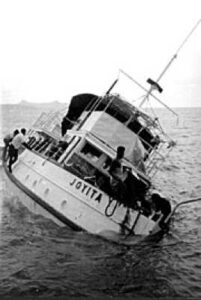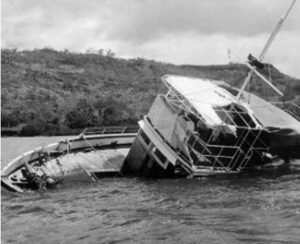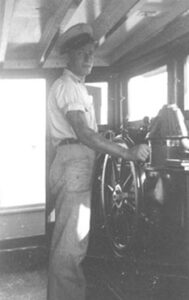 MV Joyita, an American merchant vessel, was acquired by the United States Navy in October of 1941. She was not a big ship and only ran with a crew of 25 men. Joyita was a 69-foot wooden ship built in 1931 as a luxury yacht by the Wilmington Boat Works in Los Angeles. She was originally built for movie director Roland West, who named the ship for his wife, actress Jewel Carmen. The word “joyita” in Spanish meaning “little jewel.” The ship’s hull was constructed of 2-inch-thick cedar on oak frames. She was 69 feet long, with beam of 17 feet and a draft of 7 feet 6 inches. her net tonnage was 47 tons and her gross tonnage approximately 70 tons. She had tanks for 2,500 US gallons of water and 3,000 US gallons of diesel fuel. In 1936 West sold the ship to Milton E Beacon. During this period, she made numerous trips south to Mexico and to the 1939–1940 Golden Gate International Exposition in San Francisco. During part of this time, Chester Mills was the captain of the vessel.
MV Joyita, an American merchant vessel, was acquired by the United States Navy in October of 1941. She was not a big ship and only ran with a crew of 25 men. Joyita was a 69-foot wooden ship built in 1931 as a luxury yacht by the Wilmington Boat Works in Los Angeles. She was originally built for movie director Roland West, who named the ship for his wife, actress Jewel Carmen. The word “joyita” in Spanish meaning “little jewel.” The ship’s hull was constructed of 2-inch-thick cedar on oak frames. She was 69 feet long, with beam of 17 feet and a draft of 7 feet 6 inches. her net tonnage was 47 tons and her gross tonnage approximately 70 tons. She had tanks for 2,500 US gallons of water and 3,000 US gallons of diesel fuel. In 1936 West sold the ship to Milton E Beacon. During this period, she made numerous trips south to Mexico and to the 1939–1940 Golden Gate International Exposition in San Francisco. During part of this time, Chester Mills was the captain of the vessel.
In October 1941, two months before the attack on Pearl Harbor, Joyita was acquired by the United States Navy and taken to Pearl Harbor, Hawaii, where she was outfitted as yard patrol boat YP-108. The Navy used her to patrol the Big Island of Hawaii until the end of World War II. In 1943 she ran aground and was heavily damaged, but the Navy was badly in need of ships, so she was repaired. At this point, new pipework was made from galvanized iron instead of copper or brass. In 1946, the ship was surplus to Navy requirements and most of her equipment was removed. 
She was decommissioned and in 1948, Joyita was sold to the firm of Louis Brothers. They added a cork lining was added to the ship’s hull along with refrigeration equipment. The ship also had two Gray Marine diesel engines providing 225 horsepower, and two extra diesel engines for generators. Joyita was sold to William Tavares in 1950, but he decided he didn’t really need it, so he sold it in 1952 to Dr Katharine Luomala, a professor at the University of Hawaii. Luomala chartered the boat to her friend, Captain Thomas H “Dusty” Miller, a British-born sailor living in Samoa.
Miller used the ship as a trading and fishing charter boat. About 5:00 AM on October 3, 1955, Joyita left Samoa’s Apia harbor bound for the Tokelau Islands, about 270 miles away. They got a late start, because her port engine clutch failed. Joyita eventually left Samoa on one engine. She was carrying sixteen crew members and nine passengers, including a government official, a doctor (Alfred “Andy” Denis Parsons, a World War II  surgeon on his way to perform an amputation), a copra buyer, and two children. Her cargo consisted of medical supplies, timber, 80 empty 45-gallon oil drums, and various foodstuffs. Joyita was scheduled to arrive in the Tokelau Islands on October 5th, after an expected voyage of 41 and 48 hours. On October 6th, a message from Fakaofo port reported that the ship was overdue. No distress signal from the crew was ever received. A search-and-rescue mission was launched and, from October 6th to 12th, Sunderlands of the Royal New Zealand Air Force covered a probability area of nearly 100,000 square miles of ocean, but no sign of Joyita or any of her passengers or crew was found. Five weeks later, on November 10th, Gerald Douglas, captain of the merchant ship Tuvalu, en route from Suva to Funafuti, sighted Joyita more than 600 miles west from her scheduled route, drifting north of Vanua Levu. The ship was partially submerged and listing heavily (her port deck rail was awash) and there was no trace of any of the passengers or crew. Also missing was her four tons of cargo. The recovery party noted that the radio was discovered tuned to 2182 kHz, the international marine radiotelephone distress channel. No sign of the passengers or crew was ever found.
surgeon on his way to perform an amputation), a copra buyer, and two children. Her cargo consisted of medical supplies, timber, 80 empty 45-gallon oil drums, and various foodstuffs. Joyita was scheduled to arrive in the Tokelau Islands on October 5th, after an expected voyage of 41 and 48 hours. On October 6th, a message from Fakaofo port reported that the ship was overdue. No distress signal from the crew was ever received. A search-and-rescue mission was launched and, from October 6th to 12th, Sunderlands of the Royal New Zealand Air Force covered a probability area of nearly 100,000 square miles of ocean, but no sign of Joyita or any of her passengers or crew was found. Five weeks later, on November 10th, Gerald Douglas, captain of the merchant ship Tuvalu, en route from Suva to Funafuti, sighted Joyita more than 600 miles west from her scheduled route, drifting north of Vanua Levu. The ship was partially submerged and listing heavily (her port deck rail was awash) and there was no trace of any of the passengers or crew. Also missing was her four tons of cargo. The recovery party noted that the radio was discovered tuned to 2182 kHz, the international marine radiotelephone distress channel. No sign of the passengers or crew was ever found.


One Response to MV Joyita Mystery